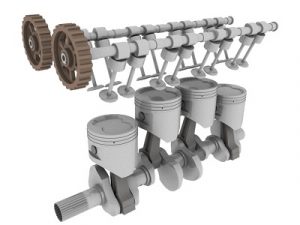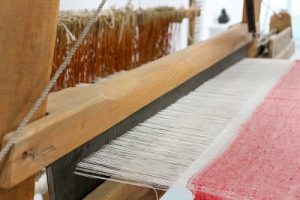Cam and follower is a mechanism used to get the desired motion such as reciprocating or translational from an available input, usually rotational.
The cam and followers have numerous applications in industries and real life. Its application varies from simple child toys to high precision valve systems in IC engine. Here we are discussing about some of the examples of cam and follower.
We will discuss 10 cam and follower examples
Cam and follower in IC engine
Valves in IC Engine
There are two valves in a four-stroke IC engine. The suction valve and exhaust valve. Those valves have to be opened accurately for the better performance of the IC engine. The suction valve should open during air intake to the cylinder, and the exhaust valve should open to remove the combustion product. The accurate opening of these valves is operated by a cam and follower mechanism.
Generally, a radial plate cam with a flat-faced or spherical follower is used.
Generally, an engine consists of multiple cylinders; hence, each cylinder requires a cam mechanism. All the cams are located on a camshaft. The camshaft is linked with the crankshaft through a chain or belt drive or gear mechanism. Hence, the camshaft is driven by the engine itself.
The number of camshafts varies with the engine. The figure shows two camshafts, one for the exhaust valve and one for the suction valve.
Operation of the fuel pump in Diesel engine
The fuel pumps are used in the Diesel engine. In a Diesel engine, the only air is added to the cylinder in the suction stroke; after compressing the air to high temperature and pressure, fuel is injected through a fuel pump. The fuel pumps are operated by a cam and follower mechanism similar to the valves.
Separate camshafts are provided for using the fuel pump in the engine.

Credit: https://commons.wikimedia.org/wiki/File:Engine_movingparts.jpg#filelinks

Credit: https://www.flickr.com/photos/mompl/272528669
Cam and Follower in Industries
Cam automatic lathe
An automatic cam lathe is a machine in which the movements of tools are controlled by the cam and follower mechanism. This machine has high speed, high accuracy, and less noise.
The tool has to move axially and radially; two cams are provided in automatic lathes; a cylindrical cam and a plate cam. The plate cam is used to provide the radial motion of the follower, and the cylindrical cam is used to provide the axial motion of the tool.
Cam indexer
The cam and follower are commonly used in the automatic manufacturing system. The application of cam is automatic indexing of the tool; hence the cam follower system is known as cam indexer. The primary purpose is the positioning of the tool.
The cylindrical cam or globoid cam with a rotating follower is used in cam indexing.
During the cam indexing period, the tool rotates and comes to the required location, then comes the dwelling period. The machining operation is carried out during the dwelling. The cycle is repeated.
The automatic screwdriver, rivets, etc., are some examples where cam indexers are used.
Weaving industry
Cam and follower are used extensively used in a weaving machine to get the shedding motion.
Shedding is the process of separating the warp yarns to make the space for passing the filling yarn. In weaving, one warp yarn is lifted above the other warp yarn, and the filling yarn is passed through the space; after this, the lifted warp yarn is returned, and the other warp yarn is lifted, and the filler yarn is passed through the space. The process is repeated. Hear, we can see the ascend, dwell, descend and dwell of the follower. There are two followers which are connected to the warp yarns. Hence, the conjugate cam and follower mechanism is used for this purpose.

Paper cutting
There are mainly two motions in paper cutting. The transverse motion of paper that is to be cut and the motion of the tool. The tool is operated by a cam and follower mechanism. The tool is connected to the follower, and the tool reciprocates. When the tool is not cutting the paper, the paper makes the transverse motion using the Geneve mechanism.
Automatic copying machine
The cam and follower mechanism can be used to copy the surface profile of a component. Usually reciprocating cam is used for this purpose.
We need to copy the cam profile in this scenario. Hence the follower is mounted on the cam with a cutting tool on the other end. During the reciprocatin motion of the cam the follower cut the workpieces which is mounted on the other side of the follower. The workpiece profile will be same as that of the cam in the end of the cutting operation.
Cam and follower in real life
Wall clocks
The cam and follower mechanism are used in wall clocks.
The heart shaped cam were used in early post office model clocks to synchronise the clock time with Greenwich Mean Time.

Toys
Different variety of toys can be made using cam and follower mechanisms. The mechanism can achieve the repeated motion in toys very easily.

Pin Tumbler Lock
Pin tumbler lock is special kind of lock where cam and follower mechanism is used to prevent the opening of the lock without the proper key.

The figure shows the working of pin tumbler lock.
The first two figures shows the operation when the correct key is inserted. When we insert the correct key, the gap between driver pin(blue) and key pin (red) align with the edge of the plug (yellow), which allows the free rotation of the plug hence the lock can be opened.
When wrong key is inserted (left bottom figure), the key pin and driver pin gap will not along with the plug, hence it prevent the opening of the key.
The last figure (bottom right) shows the position of key pin and driver pin when key is not inserted.
FAQ
Why cam and follower are used?
Cam and follower mechanism is extensively used in ic engine, industries and in real life.
It is a simple, compact mechanism that can work with high accuracy, and a large variety of motions can be generated by the proper design of cam profile.
What are the applications of cam and follower?
There is a variety of applications for cam and follower. Some are listed below.
- The valves of IC engines are operated by cam and follower
- Conjugate cam is used in the weaving industry for getting shedding motion
- A large variety of toys uses a cam and follower mechanism.
- Cam and follower are used in automatic lathe machines.
- Cam mechanism used for tool indexing
- Cam and follower are used in paper cutting machines.
- Cam and followers are used in conveyor belts.
What is the material used for making camshafts?
Chilled cast iron is used for making the cam shafts.
What is the application of cam and follower in the weaving industry?
In the weaving industry cam and followers are used to get the desired motion in the process known as shedding.Shedding is the process of separating the warp yarns to make the space for passing the filling yarn. The conjugate cam follower mechanism is used.
Two concentric cams are connected on a shaft in the conjugate cam and follower mechanism, separate followers attached to each cam. The unit rotates together, and the follower rise or falls accordingly.
What are the application of cam and follower in automobiles?
The main applications of cam and follower in automobiles are given below,

The lambdageeksScience Core SME Team is a group of experienced subject matter experts from diverse scientific and technical fields including Physics, Chemistry, Technology,Electronics & Electrical Engineering, Automotive, Mechanical Engineering. Our team collaborates to create high-quality, well-researched articles on a wide range of science and technology topics for the lambdageeks.com website.
All Our Senior SME are having more than 7 Years of experience in the respective fields . They are either Working Industry Professionals or assocaited With different Universities. Refer Our Authors Page to get to know About our Core SMEs.